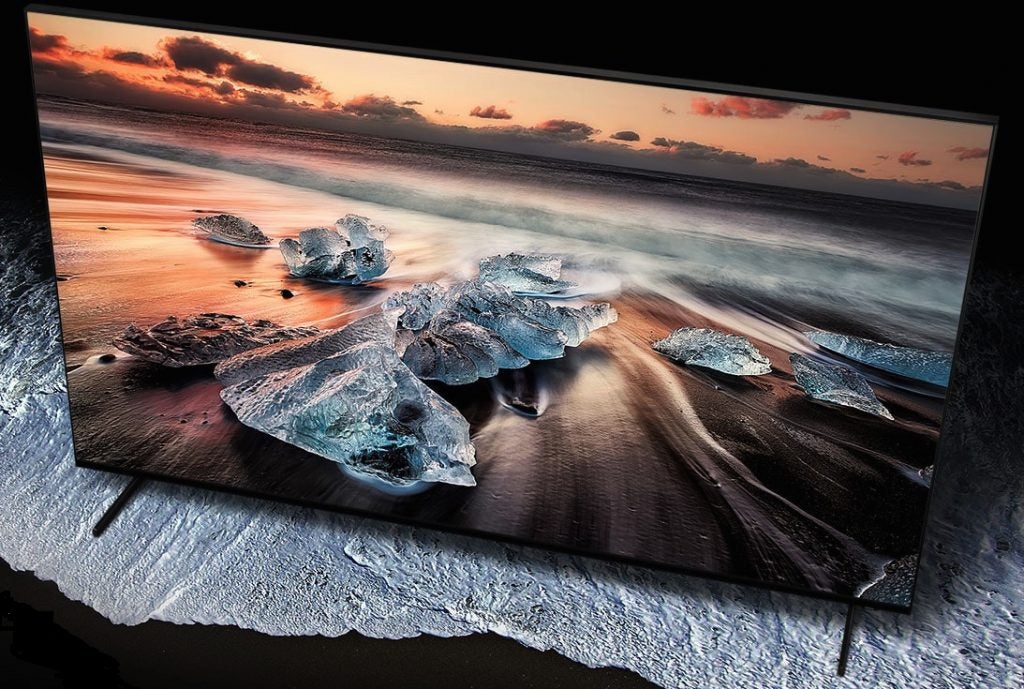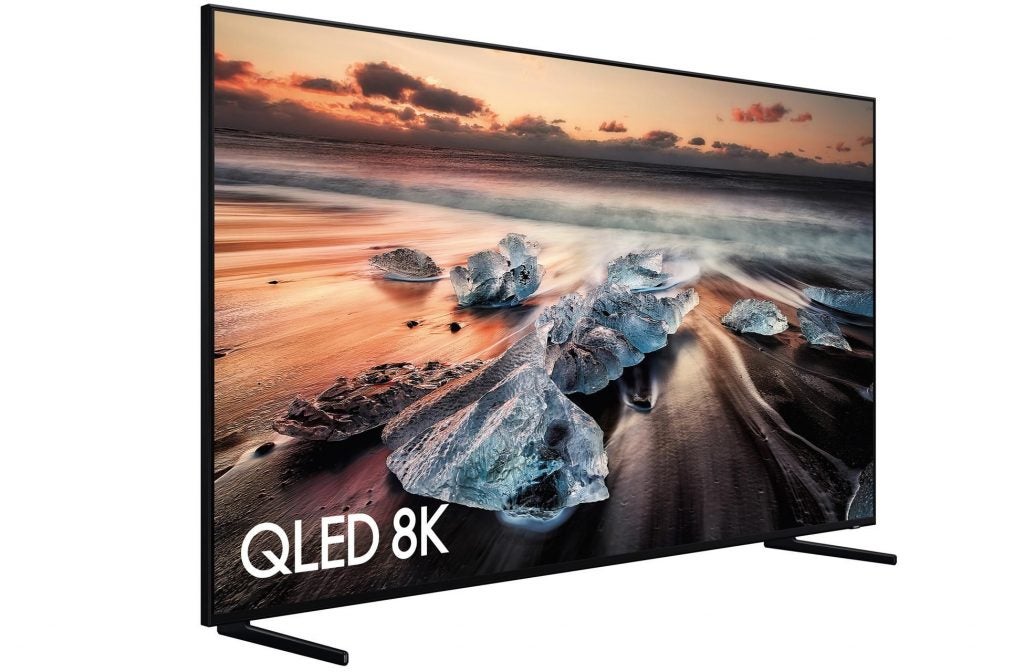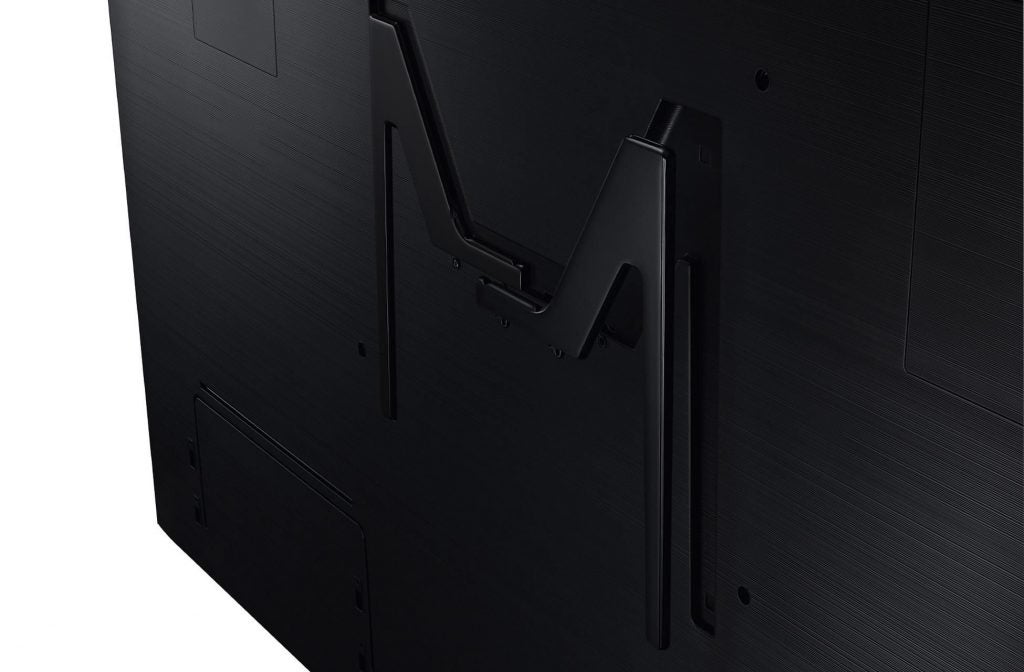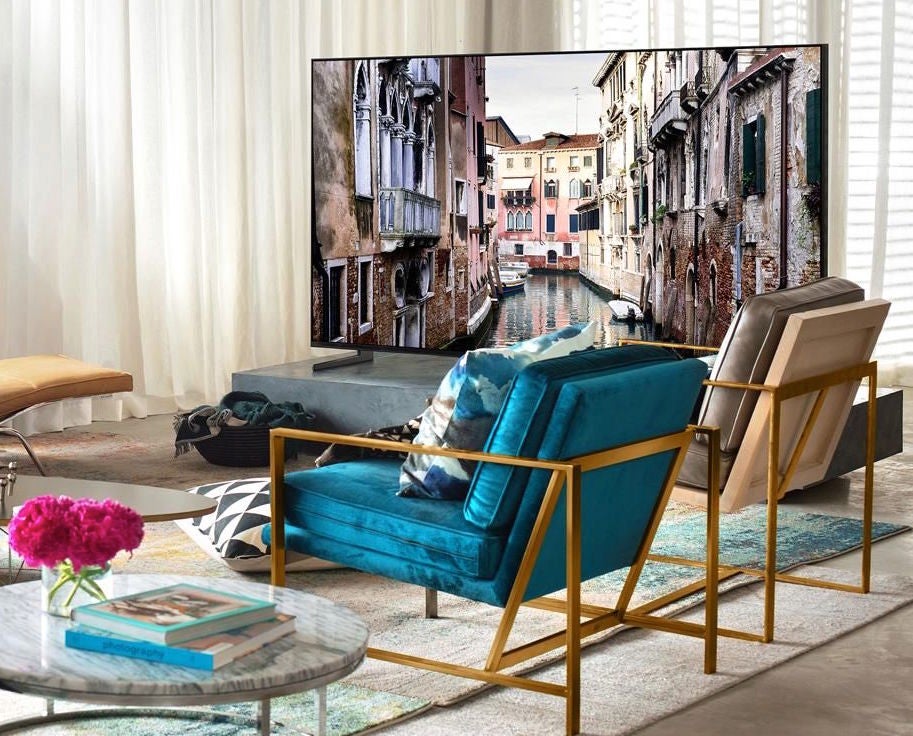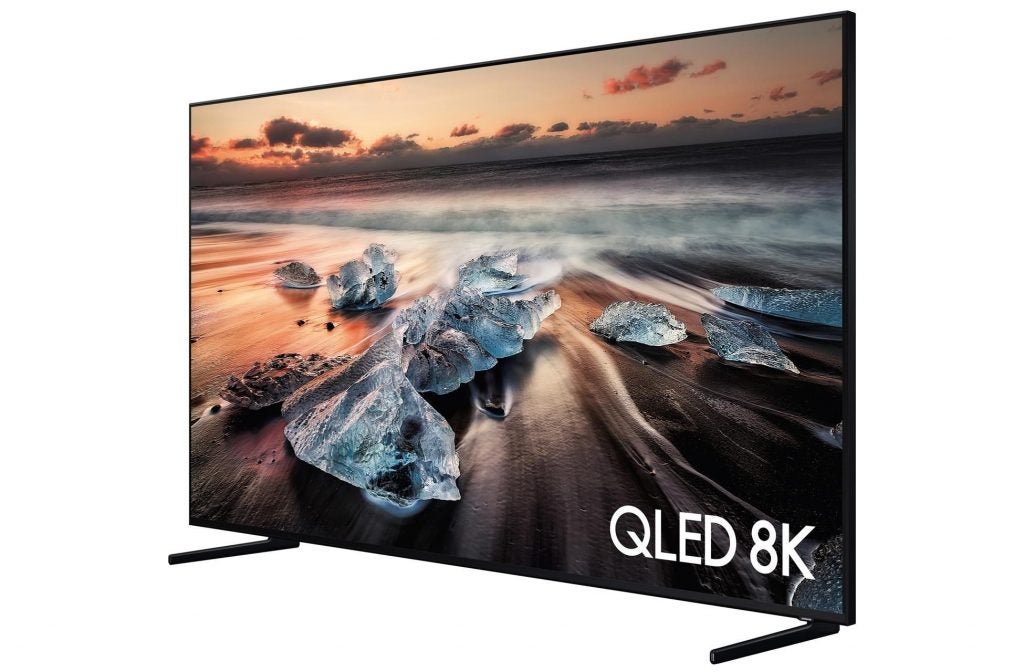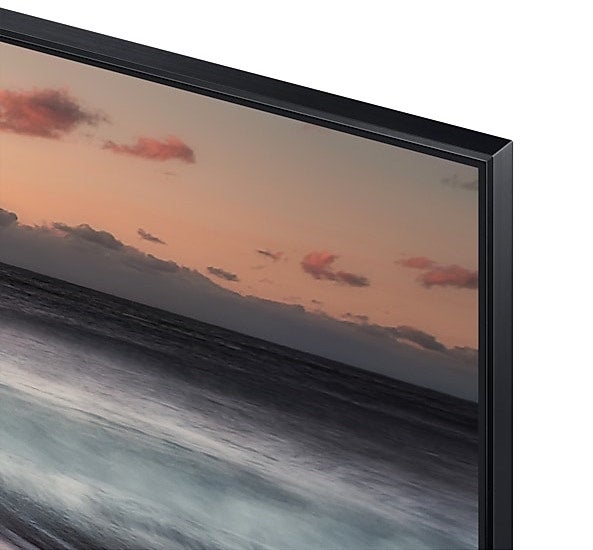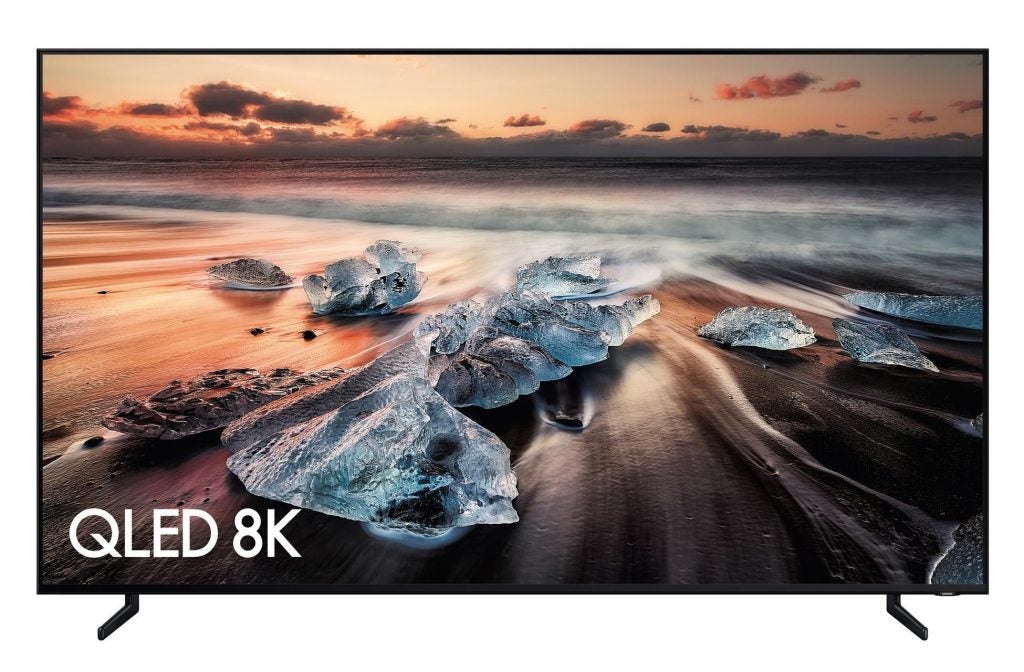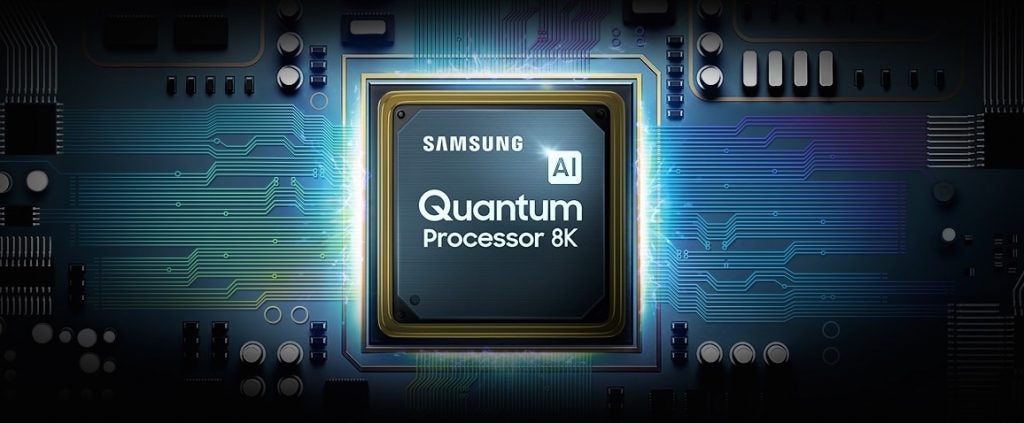Samsung QE75Q900R Review
Samsung QE75Q900R Review
8K successfully transitions from dedicated home cinema rooms to living rooms with this new 75-inch model
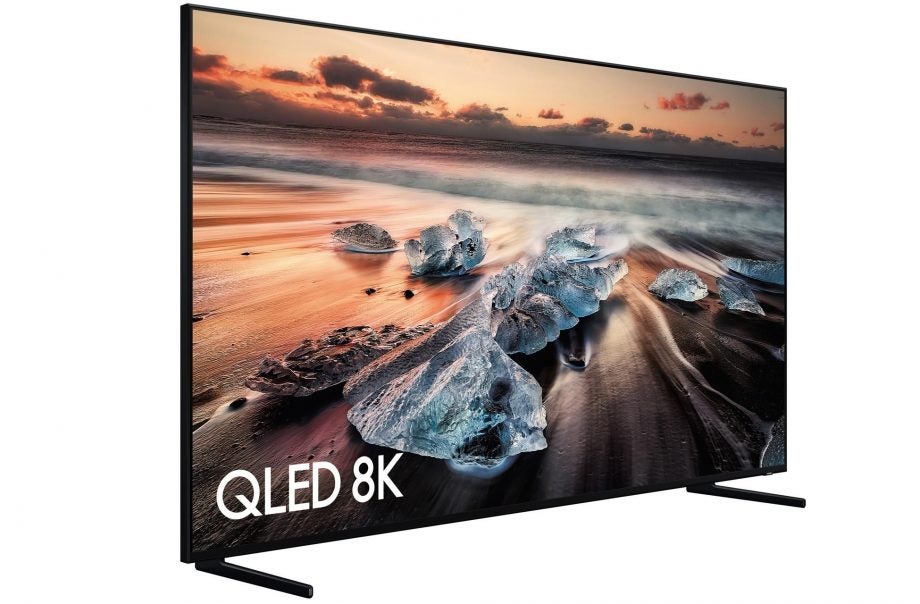
Verdict
8K's influence isn't quite as dramatic at 75 inches, but it's still there and significant
Pros
- Fantastically dynamic and punchy HDR pictures
- 8K resolution is mesmerising with native 8K content...
- ...but upscaled non-8K sources look outstanding too
Cons
- Currently no native 8K content
- Limited viewing angles
- Some backlight instability in Standard preset
Key Specifications
- Review Price: £6999
- QLED colour technology
- HDR10, HLG and HDR10+ high dynamic range support
- 75-inch LCD TV with a native 8K resolution
- Direct LED lighting with 480 local dimming zones
- Eden smart TV platform
What is the Samsung QE75Q900R?
The Samsung QE75Q900R is a 75-inch 8K television. Yes, that’s right, 8K – meaning it has 7680 x 4320 pixels squeezed into its screen.
It also uses Samsung’s QLED technology to deliver exceptional brightness and colour volume, and the company’s new 8K AI processor to convert non-8K sources into 8K. This is pretty handy, given that there are essentially zero native 8K sources available right now.
We’ve already tested and been dazzled by the 75Q900R’s bigger, 85-inch brother. But can the impact of 8K still hit home on a smaller screen?
Related: Samsung QE85Q900R review
Samsung QE75Q900R – Design and build quality
The QE75Q900R is impressively well built. It’s one of the heaviest TVs my aching back has had to deal with in the past year, and its rear and sides show no sign whatsoever of flexing or buckling.
Its bodywork isn’t in itself the most attractive I’ve seen. It’s relatively chunky round the back by today’s standards, for instance. Its angled feet look rather plain, too – although at least you can choose to place them either under each corner of the TV or closer together towards the screen’s middle. This latter fitting option means you don’t need a particularly huge piece of furniture upon which to rest the TV.
However, as with all high-end 2018 Samsung TVs, the QE75Q900R has a neat design trick up its sleeve: Ambient mode. Select this and the TV switches into a low power setting and plays either a still image of artwork or one of your own photos, so that you’re no longer left with a gaping 75-inch black hole in your living room.
You can even take a photograph of your wallpaper/paint and have that appear on the screen, so that the TV blends magically into your decor.
To complete this “invisible TV” illusion, the QE75Q900R ships with an external connections box that attaches to the TV via a single, thin, almost transparent cable.
Samsung supplies two remote controls with the 75Q900R. One is a rather drab but actually very usable standard remote, with lots of buttons. The other is a minimalist, metallic “smart” handset that takes a bit of getting used to. Ultimately, it proves rewarding for day-to-day use, especially since it’s the only one that carries a built-in mic to support the QE75Q900R’s excellent voice-control features.
The smart remote can even automatically detect and provide control of any devices you have attached to your QE75Q900R. In practice, however, this is overly complicated by the smart remote’s limited number of buttons.
Related: What size TV should I buy?
Samsung QE75Q900R – Features
As you’d hope of a TV that costs £7000, the QE75Q900R has plenty of big-hitting features up its sleeve.
The most unusual at the time of writing is its native 8K resolution. In fact, this model is the only true 8K 75-inch TV released to date. While 8K certainly made a major impact – more than I’d expected – on Samsung’s 85-inch TV, a big question for the QE75Q900R is whether 8K still “works” at 75 inches.
Helping to unlock the sort of colour finesse so many pixels deserve/need to be partnered with is Samsung’s QLED technology. This uses special metal-clad Quantum Dots that can be driven brighter than normal QDs to produce an unprecedentedly wide colour range.
The QE75Q900R also claims a massive 4000 nits of peak brightness – something that will be key in helping the set achieve greater colour “volume” than typical LCD or OLED TVs. As I’ll discuss in the Performance section, my own measurements suggest this 4000-nit claim is actually rather optimistic. It’s still the brightest 75-inch TV around, though.
The worry whenever there’s extreme brightness on an LCD TV is how much damage this might do to its black levels. The QE75Q900R tackles this issue well, though, thanks to a direct backlighting system with a very respectable 480 separately controllable local dimming zones.
What’s more, in response to criticism I and others levelled at some light “blooming” on the QE85Q900R, Samsung has tweaked the backlight control algorithms via a firmware update with impressive results, as we’ll see later.
Also standing out on the QE75Q900R is Samsung’s latest take on its “Eden” smart platform. As well as supporting an easy-to-use and comprehensive voice-control system, this delivers a huge range of apps within a slick and tidy interface.
Among the apps available are Netflix, Amazon Prime Video, YouTube (all available in their 4K and HDR versions); all the catch-up apps for the UK’s most popular terrestrial broadcasters; Now TV; Spotify; Deezer; Chili.TV; Rakuten (again, in 4K and HDR), and many more besides.
Aside from the UK catch-up services not being available within a YouView or Freeview Play wrapper, it’s hard to see what extra content Samsung could reasonably be expected to add.
The interface looks a little dated, if I had to be super-critical. However, it’s easy to customise and hard to get “lost in”; in the end, that’s all that really matters.
The connections found on the QE75Q900R’s external connection box are mostly as you’d expect of a flagship TV. The four HDMIs can all handle 4K HDR at 60p and beyond, while three USBs and Wi-Fi/Bluetooth network options handle a wide range of multimedia file formats. The HDMIs support a couple of cool gaming features, too: automatic game mode switching when a game source is detected, and variable refresh rate support for instance.
The only problem is that none of the HDMIs are built to the recently specified HDMI 2.1 specification. This means they can’t handle the data bandwidths necessary for 8K at 60Hz or more. Fortunately, Samsung has promised to build a new connections box carrying an HDMI 2.1 port at some point next year – and it’s further promised to supply this new box free of charge to any existing Q900R owner who asks for one.
Of course, you might well think that all this talk of 8K source compatibility is rather moot when there aren’t actually any native 8K sources available. In fact, you may well be thinking that there isn’t much point buying an 8K TV at all when there aren’t yet any 8K sources.
Such sources will surely come from somewhere eventually, though – and when they do, the QE75Q900R needs to do whatever it can to make sure it’s compatible with them.
There’s another important 8K angle to consider, in the shape of Samsung’s 8K AI processing engine. This uses huge amounts of processing power and picture know-how to convert lower resolution sources into 8K, in real-time. And it works well enough to count as a game changer, as we’ll see in the Performance section.
Samsung’s Optimised Sound option, meanwhile, automatically adjusts the sound settings based on an assessment of the type of sound being played at any given moment.
It supports the HDR10, HLG and HDR10+ high dynamic range formats, but not Dolby Vision. And finally, it takes less than 20ms to render its pictures with its Game picture mode selected.
Related: HDMI 2.1 – What you need to know
Samsung QE75Q900R – Setup
Before you do anything else, turn off the QE75Q900R’s Eco picture functions. These – especially the setting that adjusts the picture in response to light levels in your room – can be particularly damaging to the picture.
One bit of good news here is that adjusting the TV’s contrast or brightness settings instantly turns the Eco settings off without you having to find them in the TV’s “General” settings menu.
When it comes to picture presets, you’re really looking at a choice between Standard and Movie. Standard delivers the most dynamic, punchy, high contrast and, for me, most all-round satisfying picture. Although you may need to turn down the backlight slightly if you feel that its default HDR images look too extreme for comfort.
Movie mode still looks flat, yellowish and a touch soft compared with a gently tweaked Standard mode, even though it’s ostensibly the most accurate setting in Samsung’s arsenal. However, it delivers the most all-round nuanced and balanced HDR light range experience, especially when it comes to shadow detailing and light consistency.
If you opt to use the Standard preset, take care not to set the local dimming to low, as the amount of shadow detail this crushes out of the picture becomes extreme.
Also worth paying attention to is the Digital Clean View feature. To keep the best balance for different sources between detail and noise, I’d suggest the following Digital Clean View setting choices: Off for 4K/8K content; Low for good-quality HD content; and Auto for SD and poor quality HD.
The QE75Q900R also makes a good argument for motion processing. Activating it on its Custom setting with its blur and judder components set to around three helps to retain more clarity in upscaled and native 8K images. Without it you consistently feel like you’re losing some of the 8K image’s remarkable clarity.
Samsung QE75Q900R – Performance
The QE75Q900R retains most of the dazzling excitement of the QE85Q900R’s pictures. And, thanks to the new firmware update, it does so with considerably less noticeable flaws.
Let’s start by pushing the QE75Q900R to the extremes of its performance with native 8K content. This comes in the form of non-HDR video clips provided on USB by Samsung, as there are, as discussed previously, no native 8K sources out there. However, the clips are quite varied, giving us a glimpse at the detail, colour and motion handling of the QE75Q900R’s 8K pictures. And while their impact isn’t as great as it was on the 85-inch TV, it’s still unlike anything I’ve seen in the 4K realm.
The clarity of some of the most detailed footage – predominantly cityscapes, views across rugged terrain and, particularly memorably, a shot of stained-glass windows in a cathedral – is spectacular. Beyond 4K, without question. Particularly when there’s some gentle motion in the frame, at which point the way your brain works to perceive resolution kicks into its highest gear.
Related: Hybrid Log-Gamma – what is it?
It’s jaw-dropping stuff at times, particularly during an Inception-like demo sequence where a cityscape tumbles around the screen.
While you feel most acutely aware of 8K’s extra detail and clarity the closer you sit to the screen, it’s still visible – particularly in the sense of depth and colour resolution –from normal viewing distances. Which in this case I put at around 3 metres.
The impact of all the extra pixels isn’t quite as great – even during the most impressive sequences – as it was on the 85-inch screen. And some of the less mind-blowing 8K sequences only look slightly better than 4K. While this reminds us of the fact that 8K is really a big-screen technology so far as consumer TV applications are concerned, there’s certainly still enough of a difference to ensure that the QE75Q900R is capable of delivering hands-down the most crystal-clear, detailed pictures ever seen on a 75-inch TV.
Moving to 4K native sources, the QE75Q900R joins the QE85Q900R in revealing the remarkable quality of Samsung’s 8K AI upscaling system. This does a stellar job of adding the tens of millions of pixels needed to turn 4K into 8K, making them look slightly more detailed while simultaneously taking remarkable care not to suppress rather than exaggerate source noise.
Pausing 4K Blu-rays on the QE75Q900R alongside a 65Q9FN clearly shows extra detail in areas such as building brickwork and the weave of clothing. All delivered without any accompanying motion artefacts, blurring, edge ringing or unwanted grittiness.
This upscaling system is even capable of spiriting away large amounts of the blocking and mosquito noise associated with heavily compressed HD and even SD internet streaming sources, or the notoriously heavily compressed broadcasts of Sky News on Freeview.
Samsung really has come up with something special with 8K AI – as it needed to, given that until native 8K content arrives, the only real arguments for buying an 8K TV are future-proofing and the potential for upscaled 4K pictures to look better than they do on a 4K TV.
Related: What is HDR?
The QE75Q900R’s brightness, meanwhile, is impressive and slightly disappointing all at the same time. Pictures certainly look consistently dazzling with HDR content, thanks to more brightness than any 75-inch TV I’ve seen before. Putting some numbers on this, in Standard mode the TV peaks at around 2890 nits on a 10% white HDR window – although this figure is only held for a very short time.
The Movie mode doesn’t peak as high, more like 1950 nits, but it retains this sort of figure for far longer than the Standard mode holds on to its higher brightness peak. In fact, brightness reduces so slowly over time with the Movie setting that I wouldn’t imagine you’d ever see the change happening with any real life content.
Of course, both of these measured “peak” figures fall some way short of the 4000 nits Samsung claims for the QE75Q900R. That’s not to say the company is necessarily lying with its 4000 nit claims; I suspect the screen really can hit 4000 nits in very small areas of the screen for very short periods of time. But I certainly couldn’t get the QE75Q900R to hit the 4000 nits and beyond figures on the 10% window like the QE85Q900R did.
Going back to the differences between the very different approaches to brightness between the Standard and Movie modes, you’re faced with a choice between a more dynamic and punchy picture in Standard mode, and a “flatter” but more stable and consistent picture in Movie mode.
This is hardly the first time we’ve come across this choice on a Samsung TV. However, the difference is noticeably more pronounced than it is with Samsung’s non-8K TVs.
The Standard setting is in most ways comfortably the most exciting, with better contrast and black levels, higher levels of average brightness with HDR content, and a richer, more dynamic look to colours.
However, dark scenes can look noticeably more unstable, with some quite obvious shifting in brightness when, say, a shot cuts abruptly from a dark scene to a bright one, and vice versa.
Related: What is Ultra HD Premium? New HDR standard explained
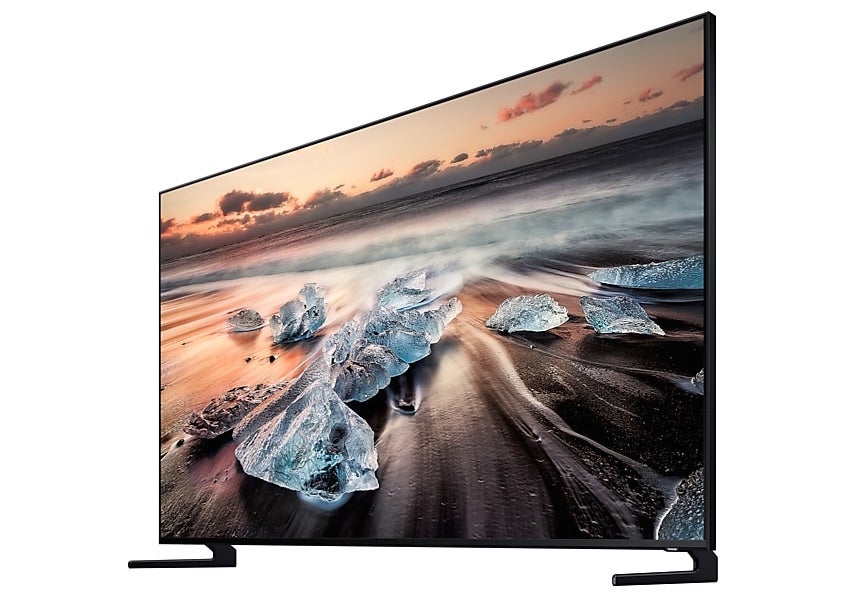
In Movie mode such instabilities are greatly reduced, but black levels are slightly greyer, and colours look flatter – although slightly more nuanced.
Both modes reveal the benefits of Samsung’s new firmware for its Q900R TVs, however. There’s now practically no “blooming” around bright objects, even when they appear against nearly black backgrounds. What’s more, this has somehow been achieved while actually increasing, rather than decreasing, the brightness of those stand-out bright areas. They still look a touch dimmer than they do on Samsung’s Q9FN TVs, but the difference is now much less dramatic.
Samsung’s new firmware also does a much better job of retaining shadow detail in very dark scenes, even if you’re using the Standard mode. “Movie” is still the best setting for shadow detail, but given the advantages in other areas of the Standard setting, it’s great to see that this mode now comes with far less black crush.
Added together, the massive reduction in backlight blooming, increased punch of stand-out bright areas and improved shadow detail rendition remove pretty much all the issues I had with the QE85Q900R’s picture. This makes it even easier to lap up the ground-breaking impact of the QE75Q900R’s resolution, brightness, contrast and colour.
Related: OLED vs LED LCD – What’s the best display technology?
On the downside, there’s no doubt that the QE75Q900R is at its absolute best with something it isn’t likely to get in any great quantity for years: native 8K content. It also still suffers with a very limited viewing angle before contrast and colour take a big hit.
Rival OLED technology still has a big advantage when it comes to viewing angles. It also delivers more consistently deep black colours than you get with even as outstanding an LED TV as the QE75Q900R. There’s more luminance intensity to very bright objects that stand out against near-black backgrounds on OLED screens, too.
However, the QE75Q900R outguns OLED substantially on brightness and colour volume. Plus, of course, there are currently no commercially available 8K OLED TVs.
The QE75Q900R’s sound isn’t as impressive as its pictures. Despite the clever efforts of Samsung’s Smart Sound technology, it tends to feel slightly swallowed and muted. The sound stage doesn’t appear as detailed, direct or large in scale as those of the best TV audio performers this year.
To be fair, with 60W of audio power spread across 4.2 channels, the QE75Q900R’s audio specification appears pretty much identical to that of the Q9FN TVs, which I reviewed pretty positively. However, the scale and dynamism of the QE75Q900R’s pictures just feel like they deserve to be partnered with a more dynamic and direct sound.
Related: What is 4K TV and Ultra HD?
Why buy a Samsung QE75Q900R?
The QE75Q900R is capable of delivering pictures the likes of which you’ve never seen before. This is especially true with native 8K content.
Crucially, though, given that native 8K content is currently non-existent outside of specially created demo reels, its 8K AI upscaling also makes good quality 4K content look better than it does on the best native 4K TVs.
In other words, if you buy one now you’re not just future-proofing yourself in preparation for a potential brave new 8K world. You’re also marginally improving your experience with today’s content.
The improvements Samsung has managed to deliver with its new firmware are excellent, solving almost all of the gripes I had with the QE85Q900R (which will also have now received the latest firmware). It’s also great to hear Samsung’s pledge to provide an updated connections box with HDMI 2.1 support (once they’re available) to any Q900R owner who wants one.
The QE75Q900R’s 8K talents don’t deliver quite as much impact as they did on the QE85Q900R. However, crucially, they’re still visible – and from normal viewing distances, too.
The one big question you have to ask yourself is just how much you’re willing to pay for the QE75Q900R’s future-proof features and cutting-edge pictures. For while £6999 is arguably not crazy money for a truly next-generation TV, it’s still £2300 more than Samsung’s 75-inch flagship 4K TV, the QE75Q9FN.
At the time of writing, you can also get the 77-inch LG OLED77C8 TV for just under £6000. That set offers support for Dolby Vision HDR, too – although, obviously, it’s only a 4K rather than an 8K TV.
Verdict
The QE75Q900R isn’t quite as spectacular as its larger 8K sibling, in terms of either its brightness or the impact of its 8K resolution. Nevertheless, it delivers the most detailed, sharp and colourful pictures of any 75-inch TV – even when you’re not watching native 8K content. If money’s no object, you certainly can’t accuse Samsung of not making the world’s first 8K TVs seriously compelling.
How we test televisions
We test every TV we review thoroughly over an extended period of time. We use industry standard tests to compare features properly. We’ll always tell you what we find. We never, ever, accept money to review a product.
Trusted Score
Score in detail
-
Features 9
-
Value 8
-
Smart TV 9
-
Image Quality 10
-
Design 9
-
Sound Quality 8
Features
| Size (Inch) | 75 |
| Display Type | LED |
| Max. Resolution | 7680 x 4320 |
| Full HD 1080p | Yes (actually 8K) |
| Digital Tuner | Yes |
| Freeview HD | Yes |
| 3D Ready | No |
| Refresh Rate (Hertz) | 200 |
Connectivity
| HDMI | 4 |
| Component | 1 |
| Digital Audio Out | Yes (optical) |
| Headphone | Yes (Bluetooth only) |
| Ethernet | 1 |
| WiFi | Yes (built in) |
Physical Specifications
| Height (Millimeter) | 964.6 |
| Width (Millimeter) | 1677 |
| Depth (Millimeter) | 34.6 |
| Weight (Gram) | 40700 |

